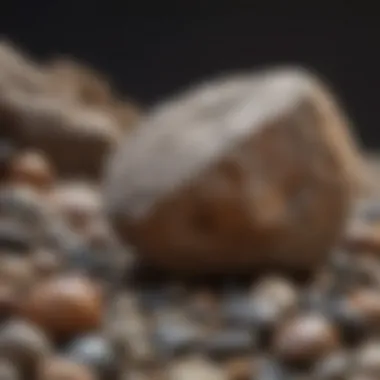Discovering Rock Tumbler Grit Options at Hobby Lobby


Intro
Rock tumbling is more than just a hobby; it’s an exploration of nature’s art. As enthusiasts dive into the world of polishing stones, they quickly realize that the right grit plays a pivotal role in achieving that stunning shine. Hobby Lobby, a widely known crafts retailer, offers a variety of tumbling grits suitable for both beginners and seasoned rock hounds. This article will guide you through the essentials of rock tumbler grit, making your journey more informed and rewarding.
In this guide, we’ll discuss the types of grit available at Hobby Lobby, how each type impacts the tumbling process, and provide practical tips for selecting the right materials. Additionally, we’ll touch on the broader context of rock tumbling as a fulfilling hobby, showcasing how retailers contribute to this community. By the end of our exploration, you’ll have a clear understanding of the grits you need and how to effectively use them.
Featured Collectible of the Month
Overview
Each month at Hobby Lobby, certain collectibles stand out, catching the interest of rock tumblers. April’s spotlight is on Amethyst. This striking purple stone is cherished for its beauty as well as its perceived metaphysical properties. Perfect for those looking to try their hand at tumbling, amethyst not only polishes beautifully but also holds significant value in the mineral collecting community.
Historical Significance
Amethyst has a rich history dating back to ancient civilizations. The Greeks believed this stone could prevent intoxication and was often worn as a protective amulet. Its name derives from the Greek word 'amethystos', meaning "not drunken." As a hobby collector today, having this stone in your collection speaks to both the natural beauty and cultural heritage of rocks and minerals.
Grit Types Available at Hobby Lobby
Coarse Grit
Starting with the basics, coarse grit (60/90 mesh) is essential for shaping your stones. This grit is aggressive, suitable for initial grinding when you want to remove rough pre-forms in a hurry.
Medium Grit
Next comes medium grit (120/220 mesh). It's like the middle child in a family; it balances between being abrasive yet allowing for a smoother finish after coarse grinding. This level is critical for gradually refining the stone's texture.
Fine Grit
Then we have fine grit (600 mesh), used for the final shaping process. This fine touch is what separates the novices from the experts. It’s where the magic happens, transitioning rough rocks into polished gems.
Polishing Grit
Finally, polishing grit, usually a 1200 mesh or greater, is what you need to achieve that reflective finish. At this stage, you get to see your stone transformed into a beautiful display piece, ready for admiration.
Tip: Always ensure you're using the right grit for the stage of tumbling. It’s common to mix things up in the beginning, but understanding each grit’s purpose will yield better results.
Selecting the Right Grit
Choosing the correct type of grit can sometimes feel like navigating a labyrinth. Here’s a list to simplify the selection:
- Know the Stone Type: Softer stones require lighter grits.
- Determine the Desired Finish: Decide how smooth or polished you want the final product.
- Trial and Error: Don’t hesitate to experiment with different grits for varied outcomes.
Enhancing Your Tumbling Hobby
Incorporating different grits into your rock tumbling experience opens up a new realm of possibilities. It’s not just about polishing stones; it’s about crafting your own little masterpieces from nature's gifts. At Hobby Lobby, you can find the tools you need, such as tumblers, grits, and polishing solutions, making it a one-stop-shop for anyone looking to enhance their tumbling hobby.
By understanding the different grits and their applications, you’ll become a more skilled rock tumbler. This knowledge not only elevates your craft, but it also deepens your appreciation for the beauty that lies within each stone.
Prolusion to Rock Tumbling
Rock tumbling is more than just a hobby; it is a journey that transforms rough stones into splendidly polished gems. This article aims to shed light on various aspects of rock tumbling, particularly focusing on the types of grit one can find at Hobby Lobby. The significance of understanding rock tumbling lies in its ability to engage enthusiasts, ignite creativity, and provide a gratifying sense of accomplishment.
The process of rock tumbling is akin to cooking—getting the right ingredients is essential for a successful outcome. Different types of grit serve as these ingredients, resulting in various finishes and textures of the rocks. Thus, choosing the proper grit not only affects the aesthetic qualities but also influences the overall tumbling outcome.
Definition and Purpose
At its core, rock tumbling is about smoothing and polishing stones through mechanical means. The primary purpose is to create visually appealing pieces for collection, jewelry-making, or decorative use. Each type of grit plays a unique role in achieving the desired finish. Coarse grit begins the process, removing sharp edges and imperfections. From there, medium grit refines the surface, fine grit polishes it up, and, ultimately, polishing grit adds a shiny, lustrous look. By meticulously selecting and utilizing these grit types, hobbiests can cultivate their own collection of beautiful, polished stones.
Historical Context
Rock tumbling has evolved over the years, growing from a simple pastime to a widespread hobby embraced by many. Early forms of stone polishing date back to ancient civilizations where stones were shaped and smoothed for tools or ornamental purposes. Hand-held methods like rubbing stones on harder surfaces were commonplace until the introduction of mechanical tumblers in the late 19th century.


With advancements in technology, the process of tumbling became accessible to the average individual. Hobby Lobby, among other retailers, began offering various supplies that made rock tumbling a feasible hobby for novices and experts alike. The tranquil yet productive nature of the craft not only offers a way to unwind but also connects individuals with the earth and its natural beauty, making it a hobby with deep historical roots and modern appeal.
Understanding Grit Types
In the world of rock tumbling, understanding the different types of grit is akin to knowing the right ingredients to bake a perfect cake. Each type of grit has its specific role in the tumbling process, and their correct use can dramatically influence the final outcome of your polished stones. Knowing how to select and apply these grits is not just a matter of preference; it’s essential for achieving desirable results.
By grasping the characteristics of coarse, medium, fine, and polish grits, hobbyists can enhance their skills and improve the appearance of their rocks significantly.
Coarse Grit
Coarse grit, typically ranging from 60 to 80 mesh, serves as the first step in the tumbling process. It’s like the heavy-duty sandpaper used to remove the rough edges from a piece of wood. This grit is crucial for shaping stones, helping to smooth out large imperfections and cut down to finer details. Coarse grit can handle the toughest of stones, including quartz and agate, preparing them for subsequent stages.
Using coarse grit requires careful attention. Over-tumbling can lead to excessive wear on the rocks, resulting in an undesired shape or loss of material. Therefore, it’s advisable to closely monitor the tumbling timeline, usually around 7 to 10 days, depending on the hardness of the stone. This initial phase lays the foundation for the entire polishing process, making it an indispensable step.
Medium Grit
Once the stones have been effectively shaped with coarse grit, it’s time to move on to medium grit, typically falling within the 120 to 220 mesh range. This stage is where fine-tuning begins. Medium grit is designed to refine the shape further and remove the scratches left by coarse grit. Think of it as the middle layer in a layered cake, softening the harsh edges and preparing for the finer nuances of the final look.
When using medium grit, it's recommended to continue tumbling for another week or so. However, it's vital to inspect your stones regularly. A close look will help you catch any issues early on, ensuring they don’t carry over into the polishing stages. The medium grit helps achieve an even smoother surface, setting up for the final touches.
Fine Grit
Fine grit, often between 500 to 1000 mesh, brings your stones closer to that coveted shine. This grit stage transforms the previously polished surface into something special, almost like how the final icing on a cake pulls the whole dessert together. Fine grit works to eliminate microns of surface scratches, allowing the natural beauty of each stone to emerge.
Plan for about a week of tumbling with fine grit. As the transformation happens, you might notice some stones gaining a sheen even before they enter the polishing phase. This is a sign that the work you’ve put in is paying off. A word of caution, though: Excessive tumbling with fine grit can lead to over-polishing, stripping away essential materials and textures, so keep an eye on the timer.
Pre-Polish and Polish Grit
In the final stages, pre-polish and polish grits are the icing on the cake. Pre-polish usually consists of 1200 to 3000 mesh, offering one last smoothing touch before the final shine. Applying this grit is crucial for making stones utterly flawless.
After the pre-polish stage, it’s time to bring out the big guns — polish grit. This is where the magic happens. Polish grit, often made of cerium oxide or aluminum oxide, produces that glass-like finish we all admire.
"The journey to perfectly polished stones is one of patience, observation, and creativity. Each grit type serves a singular purpose, and mastering these steps is essential for any dedicated hobbyist."
Final tumbling with polish grit requires just a couple of days, but the difference in luster can be astounding. Remember, polish grit only applies to stones that have already been processed adequately through the other stages; otherwise, the outcome won’t be satisfactory.
Choosing the Right Grit at Hobby Lobby
Grit selection is a crucial aspect in the rock tumbling process. The right grit can make or break your efforts to polish and perfect your stones. At Hobby Lobby, the range of grits available is impressive, but navigating this selection can be overwhelming. Understanding how to choose the appropriate grit not only enhances the aesthetic quality of your polished rocks but also affects the overall efficiency of the tumbling cycle. With thoughtful grit selection, you'll invest time and resources effectively, leading to more satisfying results.
Grit Selection Criteria
When selecting grit, various factors play into making the best choice for your tumbling project:
- Type of Stone: Different stones require different grits to achieve optimal results. Softer stones, like calcite, may need less abrasive grit compared to harder stones such as agates or jaspers.
- Tumbling Goals: Consider your end goal. If you're looking for a high gloss finish, you might start with a coarse grit and progress to finer grades. On the other hand, if you just want to shape your stones, you could begin with medium grit.
- Grit Size: Grit is available in various sizes, typically measured in mesh. Coarser grits (around 60-80 mesh) are used for initial shaping, while medium grits (around 220-600 mesh) and fine grits (1000 mesh and up) are used for smoothing and polishing.
- Availability: Since you’re shopping at Hobby Lobby, consider the grits they have in stock. Sometimes, certain brands or sizes might be limited, so adapting to what's available can save you some hassle.
- Compatibility with Tumbler: Not all grit is suitable for every type of tumbler. Make sure the grit you choose is compatible with your specific model to avoid any operational issues.
Comparing Brands and Products
When you visit Hobby Lobby, you might notice multiple brands and products for rock tumbling grit. Here are a few tips on how to compare these options effectively:
- Read Reviews: Products might be labelled, but what others say can carry a lot of weight. Checking reviews can give insights into effectiveness and performance.
- Check Product Information: The details on packaging often include helpful information regarding the grit’s composition, mesh size, and recommendations for types of stones.
- Pricing: Prices may vary between brands. It’s wise to balance quality and cost; sometimes, investing a bit more upfront pays off in the long run.
- Local and Online Feedback: Don’t shy away from checking forums or community groups like reddit.com for discussions about favorite brands. Fellow enthusiasts often share which grits yield the best results.
"The right grit is like a secret recipe; it brings out the best in your rocks, turning them from rough to refined."
In summary, choosing the right grit at Hobby Lobby involves understanding your stones, knowing your tumbling goals, and considering the available products carefully. Each step is vital in ensuring your tumbling experience is rewarding, transforming unremarkable rocks into stunning pieces of polished art.
Operating a Rock Tumbler
Operating a rock tumbler is a central aspect of the rock polishing hobby, as it incorporates not just the machinery itself but also the process that transforms raw stones into polished gems. This undertaking is more than just a fun pastime; it serves as a means to develop patience, precision, and an appreciation for natural beauty. Through understanding the setup and maintenance of the tumbler, as well as the tumbling process itself, hobbyists can significantly enhance their experience and outcomes in rock polishing.
Setup and Maintenance
Setting up a rock tumbler isn’t rocket science, but getting it right from the start can make all the difference in how effectively the stones are polished. First, find a stable surface where the tumbler can reside safely. An area that is secure and free from disturbances is key, as the tumbler’s operation can cause vibrations.


Concerning maintenance, regular cleaning of the tumbler barrel is essential to ensure each batch of stones is processed without interruption. Buildup of grit or residue from previous tumbles can affect the quality of your current batch. It's often wise to check the motor for unusual sounds or operations which could indicate a need for maintenance.
Keep in mind:
- Always follow manufacturer guidelines for setup.
- Inspect the sealing mechanism of the barrel to prevent leaks.
- Use a waste container for unwanted grit or debris during cleaning.
These simple practices ensure that anything you place in the tumbler receives the best treatment.
Tumbling Process Overview
The tumbling process itself is where the magic happens. Once you have set up your tumbler, loaded it with stones, and added the appropriate grit, the machine works its charm to polish those rough edges. Each stage of tumbling has a specific purpose and timeframe that varies depending on the type of grit used and the hardness of the stones.
Initially, stones undergo the coarse grit phase, where larger particles chip away any rough surfaces. You can expect this phase to take anywhere from a few days to over a week. Afterward comes the medium, fine, and then pre-polish stages typically spaced out over weeks.
"Patience is the name of the game in rock tumbling; rushing through the stages often yields less satisfying results."
Finally, in the polishing stage, a much finer grit is utilized, and that’s truly when you see the beauty of your stones shine through. As you gain experience, you'll learn the delicate balance of time and grit needed for different types of stones, which opens new avenues for creativity and personal touch in your craft.
knowledge of the entire tumbling process can transform your expectations from merely polishing stones to creating unique pieces of art.
The Rock Polishing Cycle
The rock polishing cycle is a pivotal part of achieving that high-gloss finish that enthusiasts seek. In essence, this cycle is a meticulous process involving multiple steps that gradually enhance the rocks’ visual appeal. Understanding the intricacies of each stage can mean the difference between a dull outcome and a stunning polished piece. It reflects not just on what you are creating but also embodies the patience and precision of the hobbyist.
Stages of Tumbling
Each stage of tumbling plays a crucial role in transforming raw stones into beautifully polished gems. The journey begins with the coarse grit stage, where the primary objective is to shape and smooth out sharp edges. Following this, medium grit is employed to further refine the surface, removing scratches left from the coarse phase.
Next, fine grit buffs the rock, setting the stage for pre-polish. This pre-polish step is essential; it creates a more reflective surface, preparing the particles to embrace their final polish. Once the rocks have undergone these four initial stages, they enter the final polishing grit phase, which gives them that dazzling shine.
"The beauty of rock tumbling lies not only in the final product but in the transformation process. Each stage unveils the character of the stone, turning ordinary pebbles into something extraordinary."
This methodical progression—from coarse to fine—is necessary for achieving a uniform surface. Each grit type serves a distinct purpose, and skipping stages can lead to subpar results, showing why it’s vital to respect the intricacies of each phase.
Timeframes and Expectations
The timeframe for each tumbling stage can vary significantly based on the type of rock and the desired result. As a general rule, coarse grit takes about one to two weeks, while medium grit can take an additional week or so. Fine grit and pre-polish typically require a similar timeframe, together adding more weeks for the polish stage.
However, these are just ballpark figures. Harder materials may necessitate longer durations as they resist abrasives more fervently. A common misconception is that rushing through these cycles will yield quicker results, but this often leads to frustration.
By allowing ample time at each stage, not only are you ensuring greater durability of your polished rocks, but you’re also giving yourself room to learn about the materials you’re working with.
Benefits of Rock Tumbling
Rock tumbling is not just a hobby; it's a portal to a symphony of creativity and science. The benefits here can span far and wide, appealing to a range of individuals, from casual hobbyists to dedicated rock and fossil collectors. At its core, this pastime fosters an appreciation for nature, while offering practical skills that resonate beyond the craft itself.
Enhancing Aesthetic Qualities
One of the most obvious perks of rock tumbling is the aesthetic transformation of raw stones into eye-catching polished gems. The process typically involves several stages, each refining the stone's surface and revealing its inner beauty.
- Visual Enjoyment: Polished rocks often exhibit vibrant colors and intriguing patterns that are hidden inside rough specimens. Collectors love to display these polished creations, which can be showcased in creative ways, from decorative pieces to jewelry.
- Unique Gift Creation: The effort you put into tumbling can result in unique, personalized gifts. Imagine giving a friend a piece of polished quartz you spent weeks transforming. Nothing beats a gift with a personal touch.
- Natural Artistry: Each polished rock can be seen as a little work of art. The variety in textures and colors can inspire creators in various fields, including painting and sculpture.
Beyond accommodating personal tastes, tumbling rocks can deepen one’s understanding of geology. Each stone tells a story of its formation, and as you polish it, you gain an appreciation for nature’s artistry.
Skill Development and Creativity
Rock tumbling employs a mix of skills that can contribute to a broad array of personal development. Through this engaging activity, individuals may enhance the following:
- Attention to Detail: Ensuring that each stage of the tumbling process is executed correctly requires a keen eye. Recognizing when rocks are adequately polished helps develop precision that can prove useful in life and work.
- Patience and Perseverance: Effective tumbling doesn't happen overnight; it’s a progressive process, often taking weeks to realize the final outcome. Understanding and accepting the timeline can help cultivate patience—an essential life skill in any endeavor.
- Creativity: Rock tumbling opens doors to various creative possibilities. Users can experiment with different rocks, as well as varying grit levels, unlocking fresh avenues for artistic expression. Trying new combinations or creating unique embellishments can lead to stunning results.
- Community Engagement: This hobby, like many others, often leads individuals to seek connections with like-minded enthusiasts. Whether through online forums or local groups, sharing experiences and techniques fosters a sense of camaraderie.
"The joy of rock tumbling goes beyond just the end product; it's about the journey and skills you accrue along the way."


When one stops and thinks about the benefits of rock tumbling, it’s clear that this activity provides more than just polished stones. It offers an abundant harvest of skills and experiences—transforming simple rocks into a treasure trove of personal growth.
Exploring Rock Tumbler Grit Options Beyond Hobby Lobby
Exploring grit options beyond Hobby Lobby is more than just a simple search for better materials; it's about expanding your toolkit as a rock tumbling enthusiast. While Hobby Lobby provides a decent starting point, tapping into the wider availability of rock tumbler grit can reveal a trove of choices tailored to various needs and preferences. In fact, the grit types available from other sources can often yield more satisfying results when tackling different stone types, each with their own unique characteristics.
When you consider alternatives, it opens up a conversation about quality, price points, and specific functionalities. Some grits are specifically processed for certain rocks or polishing stages, and knowing where to source them can impact your project's success significantly.
Online Retailers
Online retailers have become go-to sources for rock tumbling essentials in recent years. Websites like Amazon and specialty stores focused on geology or crafting often offer a wide range of grits. This accessibility is crucial because you can read reviews, compare prices, and gauge product effectiveness before making a purchase.
For instance, while a Local Hobby Lobby may have a limited selection, an online option like eBay might stock unique grit blends or even bulk purchases, which can be beneficial if you're looking to save some pennies in the long run.
Moreover, the ease of buying online allows you to explore brands that might not be carried in your local stores. Some gems you might find include:
- Lortone: Known for high-quality grit meant for professional results.
- Kreuser: A lesser-known brand that often offers bulk options, ideal for the serious hobbyist.
- Rock Shed: Offers specialty grits that can suit various tumbling projects, including those needing finer polishing.
Local Craft Stores
Venturing into local craft stores other than Hobby Lobby can also yield valuable finds. Stores like Michaels or Jo-Ann Fabrics sometimes stock tumbling materials, albeit in smaller quantities. While their focus is primarily on arts and crafts, you might discover niche products that can aid in your tumbling project.
Additionally, engaging with staff—who might have personal experience or knowledge in crafting—can uncover gems about what works best for different types of rock. A few people I know swear by their local stores for bundled deals on grit kits that allow experimentation without the premium price tag of branded products.
In essence, the local craft route may not provide a full breadth of polish options, but it can offer the convenience of quick availability without the wait for shipping. And let’s face it, sometimes you might need that grit in hand yesterday.
In summary, seeking out grits outside of Hobby Lobby can enhance your rock polishing experience. Both online retailers and local craft options provide distinct advantages that cater to different needs and preferences, ensuring you have what you need to achieve the desired results in your tumbling endeavors.
Community and Resources for Hobbyists
Pursuing rock tumbling as a hobby can be a gratifying venture, but diving in alone can sometimes feel like navigating a maze without a map. This is where community and resources for hobbyists become indispensable. They act not just as support networks, but also as springboards for creativity and inspiration.
Online forums and local gatherings provide a platform to exchange knowledge, share experiences, and gain insights that books or articles may not capture. The camaraderie of fellow rock tumblers can transform the solitary nature of the hobby into a collaborative experience, one that fosters learning and encourages exploration.
Online Forums and Groups
In the digital age, online forums and communities are truly where the magic happens for hobbyists. Websites like Reddit and dedicated forums allow enthusiasts to connect. Here’s why they’re worth exploring:
- Diverse Opinions: When you throw a question into a community, you open the door to a myriad of perspectives. You might discover a unique technique or a valuable tip that someone has learned the hard way.
- Resource Sharing: Often, members will share links to valuable resources. This may include articles, videos, or tips on the best grit to use, brand comparisons, and more.
- Problem Solving: Got your tumbler making weird noises? Or maybe you’re struggling with the right grit combination? Chances are, someone else has faced a similar issue and can offer advice.
- Friendly Critiques: When you finish a batch, showing it off and inviting critiques can provide an opportunity for improvement. Constructive feedback, especially from seasoned hobbyists, can be invaluable.
An example of a notable forum is Reddit's rock tumbling community. Here, users post their progress, ask for advice, and share successes.
Workshops and Classes
Participating in workshops or classes can also be instrumental in advancing your rock tumbling skills. While online discussions are fruitful, hands-on learning offers a diverse set of benefits:
- In-Person Guidance: Experienced instructors can observe your techniques and provide real-time feedback, something that’s seldom achievable online.
- Access to Tools: Many workshops will provide equipment and supplies, allowing you to experiment with different grit types and tumblers without the upfront investment.
- Networking Opportunities: Meeting fellow enthusiasts cultivates relationships that can lead to future collaborations, shared projects, and ongoing discussions about experiences or techniques.
- Motivation and Inspiration: Being around others who share a passion can reignite your enthusiasm and motivate you to try new methods in your tumbling practices.
Look for local craft stores or community centers. They often host workshops around specific hobbies, including rock tumbling, providing a springboard for connecting with others who share the same passion for the art.
"Finding a community while rock tumbling transformed my hobby from a solo affair to a vibrant part of my life. It's like having a second family!"
With strong community ties and access to resources, rock tumbling can evolve from a mere pastime into a complete journey of exploration.
End
In wrapping up this exploration into rock tumbler grit, it's essential to appreciate the multifaceted role that grit plays in the rock tumbling hobby. The process isn't merely about transforming rough stones into polished gems; it's about the journey itself. Learning about the different types of grit—from coarse to fine—empowers hobbyists to choose the right materials for their specific needs. This knowledge enhances the final product and the overall experience, allowing for more satisfying results along with personal growth.
Recap of Key Points
- Understanding Grit Types: Coarse, medium, fine, pre-polish, and polish grits all serve distinct functions.
- Choosing the Right Grit: Hobby Lobby offers a range of options that can suit varying levels of expertise and specific project needs.
- Operational Techniques: Navigating setup and maintenance to maximize the effectiveness of tumbling.
- Community Engagement: Connecting with fellow hobbyists enhances the learning experience and opens avenues for sharing experiences.
This recap underscores that becoming proficient in rock tumbling requires more than just putting stones into a tumbler. It involves a thoughtful selection of grit, understanding the tumbling cycle, and engaging with the vibrant community around this craft.
Encouragement to Start Tumbling
If you've been toying with the idea of diving into rock tumbling, there's no better time than now. It can feel daunting at first, sure, but this hobby is about experimentation and creativity. Start small—choose a few rocks and the appropriate grit from Hobby Lobby. The process will teach you patience as you wait for those raw stones to transform. And don't forget, the beauty of this activity lies in its community. Online forums and local workshops can offer precious insights and camaraderie.
So, dust off that tumbler, gather your selected grit, and dive in. Whether you're a novice or have dabbled in this craft before, rock tumbling promises endless opportunities for discovery and satisfaction. Happy tumbling!



